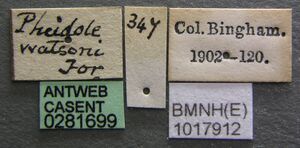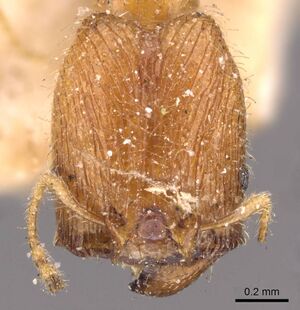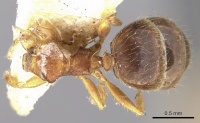Pheidole watsoni
| Pheidole watsoni | |
|---|---|

| |
| Scientific classification | |
| Kingdom: | Animalia |
| Phylum: | Arthropoda |
| Class: | Insecta |
| Order: | Hymenoptera |
| Family: | Formicidae |
| Subfamily: | Myrmicinae |
| Tribe: | Attini |
| Genus: | Pheidole |
| Species: | P. watsoni |
| Binomial name | |
| Pheidole watsoni Forel, 1902 | |
Identification
Distribution
Latitudinal Distribution Pattern
Latitudinal Range: 32.474167° to 13.72333333°.
| North Temperate |
North Subtropical |
Tropical | South Subtropical |
South Temperate |
- Source: AntMaps
Distribution based on Regional Taxon Lists
Oriental Region: Bangladesh, India, Myanmar (type locality), Nicobar Island, Sri Lanka.
Palaearctic Region: China.
Distribution based on AntMaps
Distribution based on AntWeb specimens
Check data from AntWeb
Countries Occupied
| Number of countries occupied by this species based on AntWiki Regional Taxon Lists. In general, fewer countries occupied indicates a narrower range, while more countries indicates a more widespread species. |

|
Estimated Abundance
| Relative abundance based on number of AntMaps records per species (this species within the purple bar). Fewer records (to the left) indicates a less abundant/encountered species while more records (to the right) indicates more abundant/encountered species. |

|
Biology
Castes
Images from AntWeb
   
| |
| Worker. Specimen code casent0281699. Photographer Estella Ortega, uploaded by California Academy of Sciences. | Owned by NHMUK, London, UK. |
   
| |
| Syntype of Pheidole watsoni. Worker (major/soldier). Specimen code casent0908005. Photographer Z. Lieberman, uploaded by California Academy of Sciences. | Owned by MHNG, Geneva, Switzerland. |
   
| |
| Syntype of Pheidole watsoni. Worker. Specimen code casent0908006. Photographer Z. Lieberman, uploaded by California Academy of Sciences. | Owned by MHNG, Geneva, Switzerland. |
Nomenclature
The following information is derived from Barry Bolton's Online Catalogue of the Ants of the World.
- watsoni. Pheidole watsoni Forel, 1902c: 171 (s.), 189 (w.) MYANMAR. [Also described as new by Forel, 1902f: 541.]
Description
References
- Forel, A. 1902c. Myrmicinae nouveaux de l'Inde et de Ceylan. Rev. Suisse Zool. 10: 165-249 (page 171, 189, soldier described, worker described)
- Forel, A. 1902g. Les Formicides de l'Empire des Indes et de Ceylan. Part IX. J. Bombay Nat. Hist. Soc. 14: 520-546 (page 541, also described as new)
References based on Global Ant Biodiversity Informatics
- Bharti H., Y. P. Sharma, M. Bharti, and M. Pfeiffer. 2013. Ant species richness, endemicity and functional groups, along an elevational gradient in the Himalayas. Asian Myrmecology 5: 79-101.
- Chapman, J. W., and Capco, S. R. 1951. Check list of the ants (Hymenoptera: Formicidae) of Asia. Monogr. Inst. Sci. Technol. Manila 1: 1-327
- Chen P., Y. Su, S. S. Rao, Y. F. Long, and C. H. Du. 2012. Study on the ant diversity in different Illicium verum stands. Journal of West China Forestry Science 41(1): 60-68.
- Chen Y. Q., Q. Li, Y. L. Chen, Z. X. Lu, X. Y. Zhou. 2011. Ant diversity and bio-indicators in land management of lac insect agroecosystem in Southwestern China. Biodivers. Conserv. 20: 3017-3038.
- Chen Y., C. W. Luo, H. W. Li, Y. J. Liu, H. F. Zheng, and F. C. Yang. 2013. Investigation of ant species and distribution on Wuliang Mountain. Journal of Henan Agricultural Sciences 42(5): 118-122.
- Chen Y., C.-W. Luo, H. W Li, Z. H. Xu, Y. J. Liu, and S. J. Zhao. 2011. The investigation of soil ant resources on the West slope of Mt Ailao. Hubei Agricultural Sciences 50(7): 1356-1359.
- Dad J. M., S. A. Akbar, H. Bharti, and A. A. Wachkoo. 2019. Community structure and ant species diversity across select sites ofWestern Ghats, India. Acta Ecologica Sinica 39: 219–228.
- Dias R. K. S. 2002. Current knowledge on ants of Sri Lanka. ANeT Newsletter 4: 17- 21.
- Fontanilla A. M., A. Nakamura, Z. Xu, M. Cao, R. L. Kitching, Y. Tang, and C. J. Burwell. 2019. Taxonomic and functional ant diversity along tropical, subtropical, and subalpine elevational transects in southwest China. Insects 10, 128; doi:10.3390/insects10050128
- Forel A. 1902. Myrmicinae nouveaux de l'Inde et de Ceylan. Rev. Suisse Zool. 10: 165-249.
- Ghosh S. N., S. Sheela, B. G. Kundu, S. Roychowdhury, and R. N. Tiwari. 2006. Insecta: Hymenoptera: Formicidae. Pp. 369-398 in: Alfred, J. R. B. (ed.) 2006. Fauna of Arunachal Pradesh. (Part -2). [State Fauna Series 13.]. New Delhi: Zoological Survey of India, iv + 518 pp.
- Guo X., Q. Lin, J. Cui, D. Gao, S. Xu, and Z. Sheng. 2014. Biodiversity and spatial distribution patterns of ant species in tea gardens of Chongqing. Chinese Journal of Eco-Agriculture DOI: 10.3724/SP.J.1011.2014.31052
- Guénard B., and R. R. Dunn. 2012. A checklist of the ants of China. Zootaxa 3558: 1-77.
- Liu X. 2012. Taxonomy, diversity and spatial distribution characters of the ant family Formicidae (Insecta: Hymenoptera) in southeastern Tibet. PhD Thesis 139 pages
- Liu X., Z. Xu, N. Yu, and C. Zhang. 2016. Distribution patterns of ant species ( Hymenoptera: Formicidae) in Galongla Mountains and Medog Valley of Southeastern Tibet. Scientia Silvae Sinicae 52(11): 88-95.
- Mathew R., and R. N. Tiwari. 2000. Insecta: Hymenoptera: Formicidae. Pp. 251-409 in: Director; Zoological Survey of India (ed.) 2000. Fauna of of Meghalaya. Part 7. [State Fauna Series 4.] Insecta 2000. Calcutta: Zoological Survey of India, 621 pp.
- Mohanraj P., M. Ali, and K. Veerakumari. 2010. Formicidae of the Andaman and Nicobar Islands (Indian Ocean: Bay of Bengal). Journal of Insect Science 10: Article 172
- Mohanraj, P., M. Ali and K. Veenakumari. 2010. Formicidae of the Andaman and Nicobar Islands (Indian Ocean: Bay Of Bengal). Journal of Insect Science 10:172.
- Narendra A., H. Gibb, and T. M. Ali. 2011. Structure of ant assemblages in Western Ghats, India: role of habitat, disturbance and introduced species. Insect Conservation and diversity 4(2): 132-141.
- Pajni H. R., and R. K. Suri. 1978. First report on the Formicid fauna (Hymenoptera) of Chandigarh. Res. Bull. (Science) Punjab University 29: 5-12.
- Pan Y.S. 2007. Systematic Study on the Ant Genera Pheidole Westwood and Aphaenogaster Mayr (Hymenoptera: Formincidae : Myrmicinae) In China. Guangxi Normal University, Guangxi, China. 73 pages.
- Rajan P. D., M. Zacharias, and T. M. Mustak Ali. 2006. Insecta: Hymenoptera: Formicidae. Fauna of Biligiri Rangaswamy Temple Wildlife Sanctuary (Karnataka). Conservation Area Series, Zool. Surv. India.i-iv,27: 153-188.
- Ramachandra T. V., M. D. Subash Chandran, N. V. Joshi, A. Narendra, and T. M. Ali. 2012. Ant species composition and diversity in the Sharavathi Rivers basin, central Western Ghats. Sahyadri Conservation Series 3, ENVIS Technical Report 20. 51 pages.
- Song Y., Z. H. Xu, C. L. Li, Y. Q. Hao, and H. B. Li. 2014. Ant communities of Nangun River Nature Reserve in Yunnan. Journal of West China Forestry Science 45(5): 93-100.
- Song Y., Z. Xu, C. Li, N. Zhang, L. Zhang, H. Jiang, and F. Mo. 2013. An Analysis on the Ant Fauna of the Nangun river Nature Reserve in Yunnan, China. Forest Research 26(6): 773-780.
- Tiwari R.N., B.G. Kundu, S. Roychowdhury, S.N. Ghosh. 1999. Insecta: Hymenoptera: Formicidae. Pp. 211-294 in: Director; Zoological Survey of India (ed.) 1999. Fauna of West Bengal. Part 8. Insecta (Trichoptera, Thysanoptera, Neuroptera, Hymenoptera and Anoplura). Calcutta: Zoological Survey of India, iv + 442 pp.
- Wang W. R., S. Q. Zhang, and Z. H. Xu. 2012. A faunistic and taxonomic study of ants (Hymenoptera: Formicidae) in Shenzhen Municipality. Journal of Southwest Forestry University 32(1): 64-73.
- Wang W., S. Zhang, and Z Xu. 2012. Distribution patters of ant species in Shenzhen City. Journal of Southwest Forestry University 32(3): 70-74.
- Wang W., S. Zhang, and Z. Xu. 2012. Distribution Patterns of Ant Species in Shenzhen City. Journal of Southwest Forestry University 32(3): 69-74.
- Xu Z. H., B. L. Yang, and G. Hu. 1999. Formicidae ant communities in fragments of montane rain forest in Xishuangbanna, China. Zoological Research 20(4): 288-293.
- Xu Z. H., J. G. Li, Q. Z. Fu, and Q. Z. Long. 2001. A Study on the Ant Communities on West Slope at Different Elevation of theGaoligongshan Mountain Nature Reserve in Yunnan, China. Zoological Research 22(1): 58-63.
- Xu Z., Y. Du, and B. Yang. 1998. Seven species of the ant genus Pheidole Westwood newly recorded in China (Hymenoptera: Formicidae). Journal of Southwest Forestry College 18: 227-235.
- Xu Z., Liu T.-Y., He Y.-F. and Zeng G. 1998. A comparative study on the ant communities in primeval and secondary forests of four vegetation subtypes in Xishuangbanna of China. Zoological Research 20: 360-364.
- Zhang N. N., Y. Q. Chen, Z. X. Lu, W. Zhang, and K. L. Li. 2013. Species diversity, community structure difference and indicator species of leaf-litter ants in rubber plantations and secondary natural forests in Yunnan, southwestern China. Acta Entomologica Sinica 56(11): 1314-1323.

